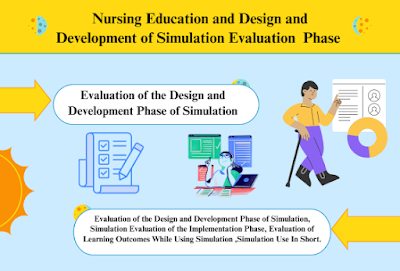The Design along Development of Simulation Evaluation Implantation and Learning Outcomes Phase In Nursing Education. The future of nursing education may lie in high-fidelity simulation: the use of computer-assisted mannequins that represent a wide range of patient conditions. Virtual reality environments also allow students to develop non-technical and interpersonal skills through a computer screen.
The Design along Development of Simulation Evaluation Implantation and Learning Outcomes Phase In Nursing Education
In nursing education, the design, development, implementation, and evaluation of simulation activities require a systematic approach. This includes defining learning objectives, selecting appropriate simulation methods, creating realistic scenarios, providing appropriate support and resources, and using robust assessment methods to evaluate learning outcomes.
Simulation-based learning (SBL) provides an educational approach that allows students to experience real-life situations with patients without exposing them to the risks associated with learning. The approach is adaptable to cases with a variety of clinical content.
Nursing simulation laboratories replicate a clinical environment and allow nursing students to safely practice nursing scenarios and hone their skills before applying them to real patients in clinical trials and professional practice.
Simulation provides nursing students with a safe and controlled environment to practice procedures and interventions without endangering real patients. This allows nursing students to learn from mistakes, gain confidence, and hone their skills before entering the clinical setting.
Development of Simulation Evaluation
1. Evaluation of the Design and Development Phase of Simulation
The design and development of simulations in nursing education are critical for ensuring their effectiveness and impact on learning outcomes. One established tool for evaluating simulation design is the Simulation Design Scale (SDS), developed by Jeffries (2005). The SDS is a 20-item instrument that allows learners to provide feedback on various aspects of the simulation, including:
- Objectives and Information: Clarity and relevance of learning objectives.
- Support and Problem Solving: Availability of resources and guidance.
- Feedback and Debriefing: Quality of feedback provided after the simulation.
- Fidelity: Realism and accuracy of the simulation environment.
The SDS helps educators refine simulation designs by offering detailed insights into these components. Its content validity was established through expert review, and it has demonstrated high reliability, with a Cronbach’s alpha coefficient of 0.94.
2. Simulation Evaluation of the Implementation Phase
The implementation phase of simulations focuses on ensuring that educational best practices are applied to create an effective learning experience. The Educational Practices in Simulation Scale (EPSS), developed as part of Jeffries’ simulation model, evaluates this phase. The EPSS is a 16-item tool that measures:
- Active Learning: Engagement and participation of students.
- Diverse Learning Methods: Variety of instructional strategies used.
- High Expectations: Standards set for student performance.
- Collaboration: Opportunities for teamwork and interaction.
The EPSS was validated through expert review and factor analysis, confirming its reliability with a coefficient alpha of 0.92. It provides valuable feedback on how well simulations adhere to established educational practices (Chickering & Gamson, 1987, 1991).
3. Evaluation of Learning Outcomes While Using Simulation
Evaluating learning outcomes from simulations involves measuring the effectiveness of these tools in closing gaps between theoretical knowledge and practical skills. Various instruments are available for this purpose:
- Laseter Clinical Judgment Rubric (Laseter, 2007): Assesses clinical judgment skills.
- Seattle University Evaluation Tool: Measures simulation effectiveness.
- Creighton Evaluation Instrument (Hayden, Keegan, Kardong-Edgren, & Smiley, 2014): Evaluates simulation-based learning.
Recent research includes the development of scoring checklists for specific simulation contexts, such as perioperative emergency training (McEvoy et al., 2014). These tools help determine the impact of simulations on student performance and learning outcomes.
4. Simulation Use in Short
Simulations play a pivotal role in enhancing learning outcomes and ensuring safe patient care environments. Key stakeholders, including nursing organizations, accrediting bodies, and academic institutions, are increasingly interested in:
- Simulation Design and Development: Identifying effective design features.
- Teaching and Learning Practices: Implementing best practices for simulation-based education.
- Implementation Processes: Ensuring successful integration into curricula.
- Learning Outcomes: Measuring the effectiveness of simulations in improving educational results.
Ongoing research and national multisite studies aim to answer critical questions about simulation efficacy, including:
- Impact on Learning Outcomes: Do simulations improve educational results?
- Design Features: What are the essential components of a well-executed simulation?
- Clinical Experience: Can simulations replace or enhance traditional clinical experiences?
- Advancing Nursing Education: How do simulations contribute to evolving nursing education?
Educators must stay informed about simulation advancements, their effectiveness in student education, and emerging research to continuously improve simulation practices in nursing education.
Read More:
https://nurseseducator.com/didactic-and-dialectic-teaching-rationale-for-team-based-learning/
https://nurseseducator.com/high-fidelity-simulation-use-in-nursing-education/
First NCLEX Exam Center In Pakistan From Lahore (Mall of Lahore) to the Global Nursing
Categories of Journals: W, X, Y and Z Category Journal In Nursing Education
AI in Healthcare Content Creation: A Double-Edged Sword and Scary
Social Links:
https://www.facebook.com/nurseseducator/
https://www.instagram.com/nurseseducator/
https://www.pinterest.com/NursesEducator/
https://www.linkedin.com/in/nurseseducator/
https://www.researchgate.net/profile/Afza-Lal-Din
https://scholar.google.com/citations?hl=en&user=F0XY9vQAAAAJ
